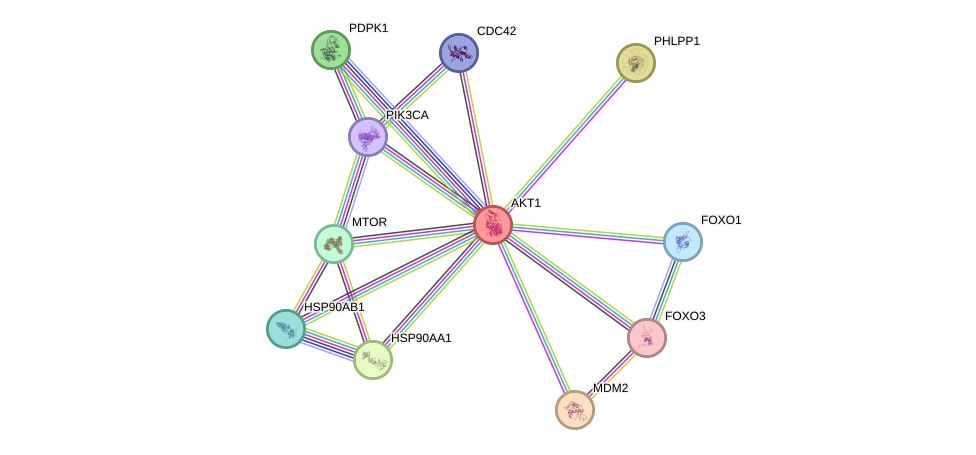GenAge entry for AKT1 (Homo sapiens)
Gene name (HAGRID: 35)
- HGNC symbol
- AKT1
- Aliases
- RAC; PKB; PRKBA; AKT
- Common name
- v-akt murine thymoma viral oncogene homolog 1
Potential relevance to the human ageing process
- Main reason for selection
- Entry selected based on evidence directly linking the gene product to ageing in a non-mammalian animal model
- Description
AKT1 is a protein kinase that is also considered an oncogene. It appears to mediate insulin's (INS) actions and be involved in the signal transduction of growth factors such as IGF1. AKT1 also impacts on cell survival and development, and it activates NFKB1 [333]. AKT1 null mice are smaller but viable and more susceptible to genotoxic stress and apoptosis [327]. Haploinsufficient mice have a lower body weight and a slightly longer lifespan (8% for males and 15% for females) [3259].
In roundworms, two AKT1 homologues play a role in insulin-like signalling and influence dauer formation [948]. Knockdown of akt-1 in roundworms extended lifespan [3259]. AKT1 also appears to play a role in cellular senescence [1660]. Some evidence suggests AKT1 may play a role in ageing through its impact on energy metabolism [823], but its role, if any, on human ageing remains elusive.
Cytogenetic information
- Cytogenetic band
- 14q32.32
- Location
- 104,769,350 bp to 104,793,601 bp
- Orientation
- Minus strand
Protein information
- Gene Ontology
-
Process: GO:0000060; protein import into nucleus, translocation
GO:0001649; osteoblast differentiation
GO:0001893; maternal placenta development
GO:0001934; positive regulation of protein phosphorylation
GO:0001938; positive regulation of endothelial cell proliferation
GO:0005978; glycogen biosynthetic process
GO:0005979; regulation of glycogen biosynthetic process
GO:0006006; glucose metabolic process
GO:0006412; translation
GO:0006417; regulation of translation
GO:0006464; cellular protein modification process
And 109 more GO terms Cellular component: GO:0005634; nucleus
GO:0005654; nucleoplasm
GO:0005737; cytoplasm
GO:0005739; mitochondrion
GO:0005819; spindle
GO:0005829; cytosol
GO:0005886; plasma membrane
GO:0005911; cell-cell junction
GO:0015630; microtubule cytoskeleton
GO:0031982; vesicle
GO:0036064; ciliary basal body
And 3 more GO terms
Show all GO termsFunction: GO:0004672; protein kinase activity
GO:0004674; protein serine/threonine kinase activity
GO:0004712; protein serine/threonine/tyrosine kinase activity
GO:0005080; protein kinase C binding
GO:0005515; protein binding
GO:0005524; ATP binding
GO:0005547; phosphatidylinositol-3,4,5-trisphosphate binding
GO:0016301; kinase activity
GO:0019899; enzyme binding
GO:0030235; nitric-oxide synthase regulator activity
GO:0032794; GTPase activating protein binding
And 5 more GO terms
Protein interactions and network
- Protein-protein interacting partners in GenAge
- TERT, HDAC3, IRS1, AKT1, PIK3CB, EGFR, BRCA1, PTEN, CREBBP, VCP, HSP90AA1, PDPK1, EP300, GSK3B, PRKDC, AR, FOXO3, FOXO1, UCHL1, APP, SIRT1, HSPA9, MAPK8, YWHAZ, MAPK14, MAPK9, MAP3K5, FOXO4, CREB1, HSPA8, MAPT, MXD1, MDM2, ESR1, MTOR, CTNNB1, PPP1CA, SIRT6, STUB1, NCOR2, NFE2L2, CDKN1A, PIK3CA, GSK3A, IKBKB, RICTOR
- STRING interaction network
Retrieve sequences for AKT1
Homologs in model organisms
In other databases
- GenAge model organism genes
- A homolog of this gene for Mus musculus is present as Akt1
- LongevityMap
- This gene is present as AKT1
- CellAge
- This gene is present as AKT1

